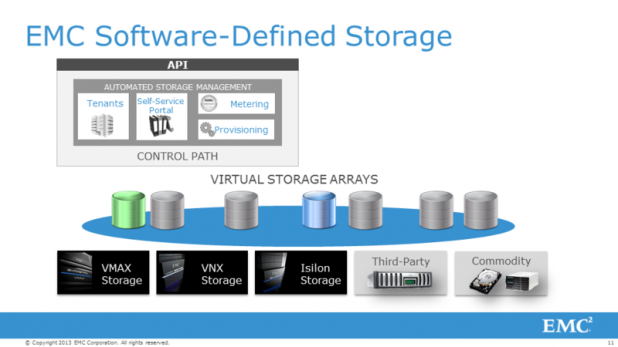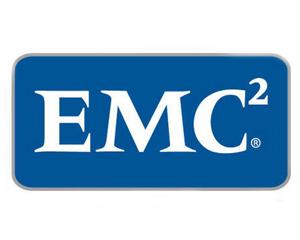 Software-Defined Networking (SDN) has become a watchword over the past few quarters. But software-defined storage is a slightly different concept—one that EMC hopes to take mainstream. This week, EMC debuted ViPR, which it positioned as the first software-defined storage platform. ViPR separates the control plane from the data plane within storage in much the same way that EMC's subsidiary, VMware, uses its own software to manage what it calls the software-defined data center. In ViPR's case, the controller provides management services from a single sheet of glass, overseeing storage hardware from both EMC as well as third-party providers. EMC said that the new ViPR technology would be available in the second half of 2013 for an undisclosed price. "By only abstracting the control plane, storage management operates at the virtual layer," Amitabh Srivastava, the president of the Advanced Software Division at EMC, wrote in a statement. "Storage administrators partition their storage pools into various virtual storage arrays and manage them uniquely by policy—just like a VMware vCenter administrator partitions servers into many virtual machines." Srivastava formerly ran the Azure business at Microsoft, so EMC is betting that he knows his stuff. Here's the way EMC breaks it all out: ViPR represents the control plane, accessing objects such as files to minimize latency. The data plane is left up to the existing storage array, leaving ViPR to get out of the way and perform analytics. Within the control architecture, ViPR sniffs out the available storage resources across the network, while the software creates storage pools and divvies them up across the available applications. EMC said that its ViPR Object Data Services wouls provide Amazon S3 and OpenStack Swift-compatible REST APIs and HDFS access methods, and that existing software applications written to these APIs should run seamlessly. Naturally, ViPR will use VMware as an overarching control mechanism, with the storage pools appearing as an array within VMware vSphere. EMC suggested that the VIPR controller will integrate with the VMware SDDR management tool and the vCenter operations manager. Chuck Hollis, the "global marketing CTO" of EMC, wrote that he viewed ViPR as belonging in three distinct buckets: first, it’s reminiscent of a storage hypervisor, abstracting storage to create new virtual arrays through a multi-tenant and metered "as-a-service" model; second, it morphs the presentation of data to meet the needs at hand; and third, it’s the beginning of a framework for doing application storage service provisioning in an advanced cloud model. VMware arguably helped usher in the most recent wave of software-defined networking craze with its acquisition of Nicira last year, so it stands to reason that EMC should capitalize on the software-defined trend with storage, as well. Image: ViPR
Software-Defined Networking (SDN) has become a watchword over the past few quarters. But software-defined storage is a slightly different concept—one that EMC hopes to take mainstream. This week, EMC debuted ViPR, which it positioned as the first software-defined storage platform. ViPR separates the control plane from the data plane within storage in much the same way that EMC's subsidiary, VMware, uses its own software to manage what it calls the software-defined data center. In ViPR's case, the controller provides management services from a single sheet of glass, overseeing storage hardware from both EMC as well as third-party providers. EMC said that the new ViPR technology would be available in the second half of 2013 for an undisclosed price. "By only abstracting the control plane, storage management operates at the virtual layer," Amitabh Srivastava, the president of the Advanced Software Division at EMC, wrote in a statement. "Storage administrators partition their storage pools into various virtual storage arrays and manage them uniquely by policy—just like a VMware vCenter administrator partitions servers into many virtual machines." Srivastava formerly ran the Azure business at Microsoft, so EMC is betting that he knows his stuff. Here's the way EMC breaks it all out: ViPR represents the control plane, accessing objects such as files to minimize latency. The data plane is left up to the existing storage array, leaving ViPR to get out of the way and perform analytics. Within the control architecture, ViPR sniffs out the available storage resources across the network, while the software creates storage pools and divvies them up across the available applications. EMC said that its ViPR Object Data Services wouls provide Amazon S3 and OpenStack Swift-compatible REST APIs and HDFS access methods, and that existing software applications written to these APIs should run seamlessly. Naturally, ViPR will use VMware as an overarching control mechanism, with the storage pools appearing as an array within VMware vSphere. EMC suggested that the VIPR controller will integrate with the VMware SDDR management tool and the vCenter operations manager. Chuck Hollis, the "global marketing CTO" of EMC, wrote that he viewed ViPR as belonging in three distinct buckets: first, it’s reminiscent of a storage hypervisor, abstracting storage to create new virtual arrays through a multi-tenant and metered "as-a-service" model; second, it morphs the presentation of data to meet the needs at hand; and third, it’s the beginning of a framework for doing application storage service provisioning in an advanced cloud model. VMware arguably helped usher in the most recent wave of software-defined networking craze with its acquisition of Nicira last year, so it stands to reason that EMC should capitalize on the software-defined trend with storage, as well. Image: ViPR EMC Gives Storage an SDN Twist
 Software-Defined Networking (SDN) has become a watchword over the past few quarters. But software-defined storage is a slightly different concept—one that EMC hopes to take mainstream. This week, EMC debuted ViPR, which it positioned as the first software-defined storage platform. ViPR separates the control plane from the data plane within storage in much the same way that EMC's subsidiary, VMware, uses its own software to manage what it calls the software-defined data center. In ViPR's case, the controller provides management services from a single sheet of glass, overseeing storage hardware from both EMC as well as third-party providers. EMC said that the new ViPR technology would be available in the second half of 2013 for an undisclosed price. "By only abstracting the control plane, storage management operates at the virtual layer," Amitabh Srivastava, the president of the Advanced Software Division at EMC, wrote in a statement. "Storage administrators partition their storage pools into various virtual storage arrays and manage them uniquely by policy—just like a VMware vCenter administrator partitions servers into many virtual machines." Srivastava formerly ran the Azure business at Microsoft, so EMC is betting that he knows his stuff. Here's the way EMC breaks it all out: ViPR represents the control plane, accessing objects such as files to minimize latency. The data plane is left up to the existing storage array, leaving ViPR to get out of the way and perform analytics. Within the control architecture, ViPR sniffs out the available storage resources across the network, while the software creates storage pools and divvies them up across the available applications. EMC said that its ViPR Object Data Services wouls provide Amazon S3 and OpenStack Swift-compatible REST APIs and HDFS access methods, and that existing software applications written to these APIs should run seamlessly. Naturally, ViPR will use VMware as an overarching control mechanism, with the storage pools appearing as an array within VMware vSphere. EMC suggested that the VIPR controller will integrate with the VMware SDDR management tool and the vCenter operations manager. Chuck Hollis, the "global marketing CTO" of EMC, wrote that he viewed ViPR as belonging in three distinct buckets: first, it’s reminiscent of a storage hypervisor, abstracting storage to create new virtual arrays through a multi-tenant and metered "as-a-service" model; second, it morphs the presentation of data to meet the needs at hand; and third, it’s the beginning of a framework for doing application storage service provisioning in an advanced cloud model. VMware arguably helped usher in the most recent wave of software-defined networking craze with its acquisition of Nicira last year, so it stands to reason that EMC should capitalize on the software-defined trend with storage, as well. Image: ViPR
Software-Defined Networking (SDN) has become a watchword over the past few quarters. But software-defined storage is a slightly different concept—one that EMC hopes to take mainstream. This week, EMC debuted ViPR, which it positioned as the first software-defined storage platform. ViPR separates the control plane from the data plane within storage in much the same way that EMC's subsidiary, VMware, uses its own software to manage what it calls the software-defined data center. In ViPR's case, the controller provides management services from a single sheet of glass, overseeing storage hardware from both EMC as well as third-party providers. EMC said that the new ViPR technology would be available in the second half of 2013 for an undisclosed price. "By only abstracting the control plane, storage management operates at the virtual layer," Amitabh Srivastava, the president of the Advanced Software Division at EMC, wrote in a statement. "Storage administrators partition their storage pools into various virtual storage arrays and manage them uniquely by policy—just like a VMware vCenter administrator partitions servers into many virtual machines." Srivastava formerly ran the Azure business at Microsoft, so EMC is betting that he knows his stuff. Here's the way EMC breaks it all out: ViPR represents the control plane, accessing objects such as files to minimize latency. The data plane is left up to the existing storage array, leaving ViPR to get out of the way and perform analytics. Within the control architecture, ViPR sniffs out the available storage resources across the network, while the software creates storage pools and divvies them up across the available applications. EMC said that its ViPR Object Data Services wouls provide Amazon S3 and OpenStack Swift-compatible REST APIs and HDFS access methods, and that existing software applications written to these APIs should run seamlessly. Naturally, ViPR will use VMware as an overarching control mechanism, with the storage pools appearing as an array within VMware vSphere. EMC suggested that the VIPR controller will integrate with the VMware SDDR management tool and the vCenter operations manager. Chuck Hollis, the "global marketing CTO" of EMC, wrote that he viewed ViPR as belonging in three distinct buckets: first, it’s reminiscent of a storage hypervisor, abstracting storage to create new virtual arrays through a multi-tenant and metered "as-a-service" model; second, it morphs the presentation of data to meet the needs at hand; and third, it’s the beginning of a framework for doing application storage service provisioning in an advanced cloud model. VMware arguably helped usher in the most recent wave of software-defined networking craze with its acquisition of Nicira last year, so it stands to reason that EMC should capitalize on the software-defined trend with storage, as well. Image: ViPR 